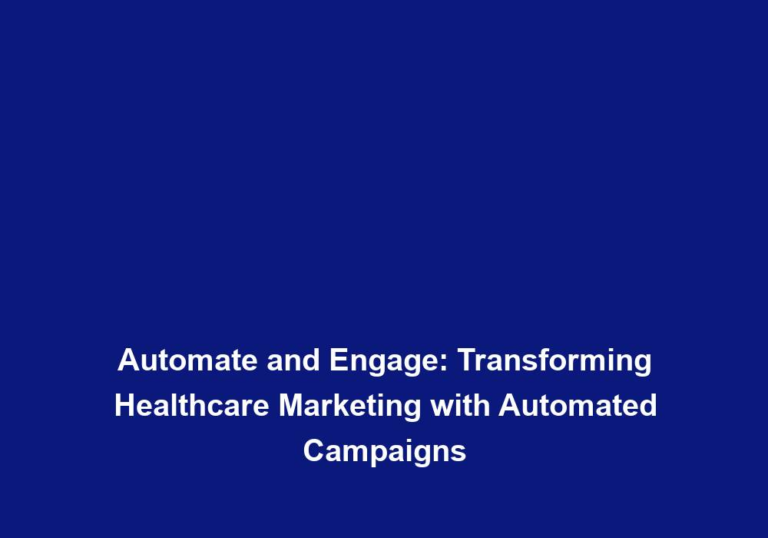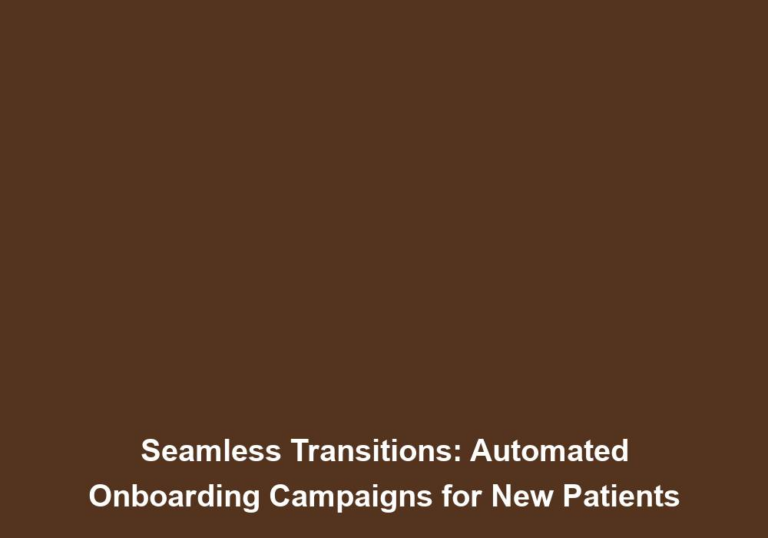Earn More, Serve More: How Affiliate Programs Can Amplify Healthcare Marketing
Affiliate marketing has become a widespread practice across various industries, and the healthcare sector is no exception. Healthcare providers, pharmaceutical companies, and medical professionals can greatly benefit from leveraging affiliate programs to amplify their marketing efforts. By partnering with affiliates, healthcare organizations can increase brand visibility, reach a wider audience, and ultimately generate more revenue. In this article, we will explore how affiliate programs can revolutionize healthcare marketing and help providers earn more while serving more patients.
What is Affiliate Marketing?
Affiliate marketing is a performance-based marketing strategy where businesses reward affiliates for each visitor or customer brought through their own marketing efforts. Affiliates, often individuals or organizations with a strong online presence, promote products or services and receive a commission for every successful referral or sale.
Affiliate marketing offers a win-win situation for both the healthcare provider and the affiliate. The provider benefits from increased brand exposure and revenue, while the affiliate earns a commission for their successful referrals. This strategy is particularly effective in the healthcare industry, where trust and credibility play a crucial role in decision-making.
The Power of Affiliate Programs in Healthcare
- Expanding Reach and Visibility: Affiliate programs enable healthcare providers to tap into new audiences and expand their reach beyond their existing patient base. By partnering with affiliates who have a dedicated following or a niche audience, healthcare organizations can gain exposure to potential patients who may not have been aware of their services otherwise.
- Affiliates with a strong online presence can leverage their influence to promote healthcare providers to their audience, resulting in increased brand visibility.
- By targeting affiliates with a niche audience, healthcare organizations can reach specific demographics or patient groups that align with their services.
- Building Trust and Credibility: Affiliates who have already built trust and credibility in the healthcare industry can help healthcare providers enhance their own reputation. When reputable affiliates endorse a healthcare organization, it lends credibility and trust to the provider, making potential patients more likely to choose their services.
- Affiliates with expertise and a positive reputation in the healthcare industry can provide valuable recommendations and endorsements, instilling confidence in potential patients.
- Endorsements from reputable affiliates can reassure patients about the quality and reliability of the healthcare provider’s services.
- Leveraging Niche Expertise: Affiliates often specialize in specific healthcare niches, such as mental health, nutrition, or fitness. By collaborating with affiliates who have expert knowledge in these areas, healthcare providers can tap into their expertise and target a more specific audience. This allows providers to tailor their marketing messages and services to meet the unique needs and interests of potential patients.
- Affiliates with niche expertise can provide valuable insights and information to potential patients, positioning the healthcare provider as an authority in that specific niche.
- By leveraging the niche expertise of affiliates, healthcare providers can create targeted marketing campaigns that resonate with their intended audience.
- Driving Traffic and Conversions: Affiliate marketing can significantly boost website traffic and conversions. Affiliates use various marketing channels, such as blogs, social media, email marketing, and search engine optimization, to promote healthcare providers and drive traffic to their websites. This increased traffic can lead to a higher number of patient inquiries, appointments, and ultimately, conversions.
- Affiliates can create engaging and informative content that educates potential patients about the healthcare provider’s services, leading to increased website traffic.
- By strategically placing affiliate links and calls-to-action, healthcare providers can encourage website visitors to take desired actions, such as scheduling appointments or making inquiries.
- Cost-Effective Marketing: Affiliate marketing can be a cost-effective marketing strategy for healthcare providers. Rather than investing substantial resources in traditional advertising methods, providers can allocate their budget towards rewarding affiliates for their successful referrals. This way, healthcare organizations pay only for the results they receive, making it a financially viable option for marketing.
- Traditional advertising methods, such as TV commercials or print ads, can be expensive and may not always yield significant results. Affiliate marketing allows healthcare providers to pay for actual conversions or referrals, ensuring a higher return on investment.
- By setting a commission structure that aligns with their budget, healthcare providers can control their marketing expenses effectively.
- Measurable Results and Performance Tracking: Affiliate programs provide healthcare providers with the ability to track and measure the performance of their marketing efforts accurately. Advanced tracking tools and analytics allow providers to identify which affiliates are driving the most traffic, conversions, and revenue. This data helps providers optimize their affiliate partnerships and make informed decisions about their marketing strategies.
- Through tracking tools and analytics, healthcare providers can monitor the performance of their affiliate program in real-time. They can identify top-performing affiliates and make data-driven decisions to improve their marketing efforts.
- By analyzing the data, healthcare providers can identify trends, preferences, and areas for improvement, allowing them to fine-tune their marketing strategies for maximum impact.
Implementing an Effective Affiliate Program in Healthcare Marketing
To harness the full potential of affiliate marketing in healthcare, healthcare providers need to establish and maintain an effective affiliate program. Here are some essential steps to consider:
Step 1: Define Program Objectives and Commission Structure
Clearly define the objectives of the affiliate program. Determine the key performance indicators (KPIs) that align with your marketing goals, such as the number of website visits, appointments scheduled, or revenue generated.
Next, establish a commission structure that incentivizes affiliates while ensuring profitability for your organization. Consider offering a percentage of the revenue generated from each successful referral or a fixed amount per conversion.
Step 2: Identify and Recruit Relevant Affiliates
Identify affiliates who have a strong online presence, align with your target audience, and possess expertise in healthcare or related niches. Research bloggers, social media influencers, and content creators in the healthcare industry and reach out to them with a compelling partnership proposal.
It is essential to establish clear guidelines and expectations for affiliates, including the channels they can use, the marketing materials they can access, and any ethical considerations they must adhere to.
- When identifying relevant affiliates, consider their audience demographics, engagement levels, and alignment with your brand values.
- Build relationships with affiliates by engaging with their content, sharing their posts, and showing genuine interest in their work.
Step 3: Provide Marketing Resources and Support
Equip affiliates with the necessary marketing resources to effectively promote your healthcare services. Provide them with high-quality banners, images, videos, and informative content that aligns with your brand.
Offer ongoing support and communication to keep affiliates engaged and motivated. Regularly update them on any new services, promotions, or changes in your organization to ensure they are always equipped with the most up-to-date information.
- Create a dedicated affiliate portal or resource center where affiliates can easily access marketing materials, track their performance, and communicate with your team.
- Provide training or webinars to educate affiliates about your services, unique selling points, and target audience.
Step 4: Monitor Performance and Optimize
Use tracking tools and analytics to monitor the performance of your affiliate program. Identify top-performing affiliates, track conversion rates, and analyze the effectiveness of different marketing channels. This data will help you optimize your program, allocate resources effectively, and make informed decisions to maximize your ROI.
- Regularly review affiliate performance metrics, such as click-through rates, conversion rates, and revenue generated, to identify areas of improvement.
- Conduct A/B testing to determine the most effective marketing materials, messaging, and landing pages.
Step 5: Regularly Evaluate and Evolve
Continuously evaluate the success of your affiliate program and make necessary adjustments to adapt to changing market trends and consumer behavior. Stay updated with emerging healthcare marketing strategies and explore new opportunities to collaborate with relevant affiliates.
- Stay informed about industry trends, new healthcare technologies, and evolving patient preferences to ensure your affiliate program remains relevant and effective.
- Regularly communicate with affiliates to gather feedback, address concerns, and identify areas for improvement.
Conclusion
Affiliate programs offer healthcare providers a powerful tool to amplify their marketing efforts, reach new audiences, and generate more revenue. By leveraging the expertise and influence of affiliates, healthcare organizations can build trust, expand their reach, and drive traffic to their websites. Implementing an effective affiliate program requires clear objectives, relevant affiliate recruitment, and ongoing support. With careful planning, monitoring, and optimization, healthcare providers can earn more while serving more patients, ultimately strengthening their position in the competitive healthcare industry.







